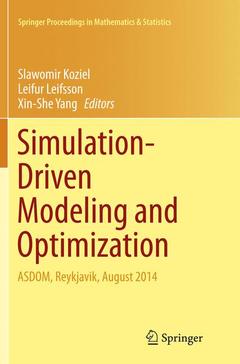Description
Simulation-Driven Modeling and Optimization, 1st ed. 2016
ASDOM, Reykjavik, August 2014
Springer Proceedings in Mathematics & Statistics Series, Vol. 153
Coordinators: Koziel Slawomir, Leifsson Leifur, Yang Xin-She
Language: English
Subject for Simulation-Driven Modeling and Optimization:
Keywords
computational modeling; computer simulation; engineering optimization; numerical optimization; simulating complex systems; computationally expensive simulation; iterative simulation design processes; surrogate-based modelling; simulation-driven design optimization; metaheuristic optimization; efficient optimization algorithms; aerodynamic optimization; gas transport network design; antenna design; microwave structure design; crystal nanostructures; algorithms; modeling; optimization
Publication date: 03-2018
Support: Print on demand
Publication date: 02-2016
404 p. · 15.5x23.5 cm · Hardback
Description
/li>Contents
/li>Comment
/li>
High-fidelity simulation models allow for accurate evaluations of the devices and systems, which is critical in the design process, especially to avoid costly prototyping stages. Despite this and other advantages, the use of simulation tools in the design process is quite challenging due to associated high computational cost. The steady increase of available computational resources does not always translate into the shortening of the design cycle because of the growing demand for higher accuracy and necessity to simulate larger and more complex systems. For this reason, automated simulation-driven design?while highly desirable?is difficult when using conventional numerical optimization routines which normally require a large number of system simulations, each one already expensive.
Presents strategies for enhancing automated simulation-driven modeling design practices
Highlights invaluable techniques for areas such as engineering, hydrodynamics, ocean science and climate modeling, where design processes are rooted in CPU-heavy computer simulations
Accessible with only a working knowledge of calculus and numerical modeling and optimization

